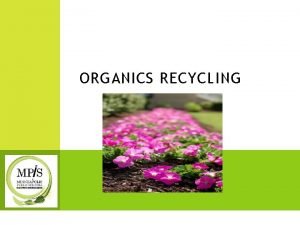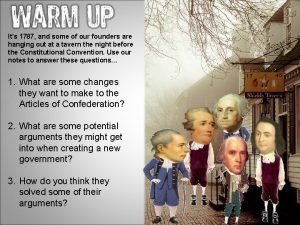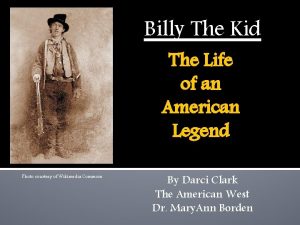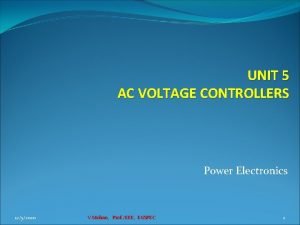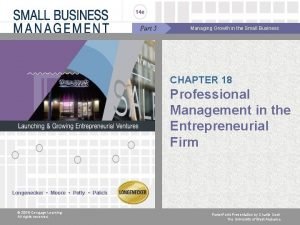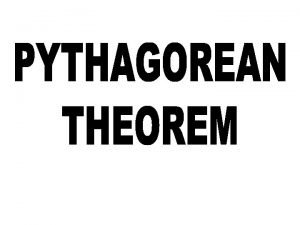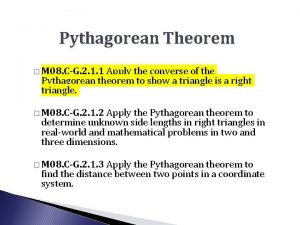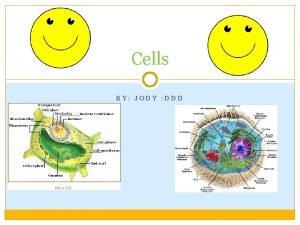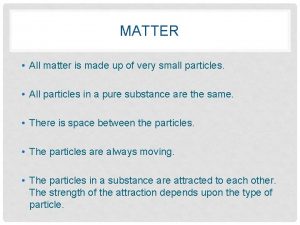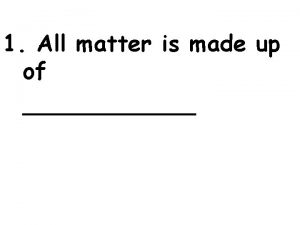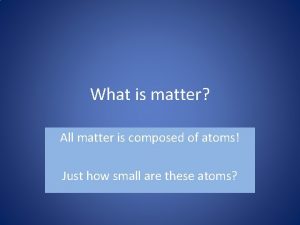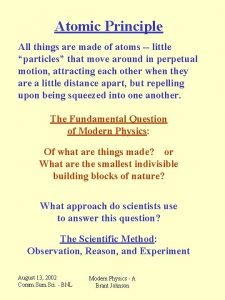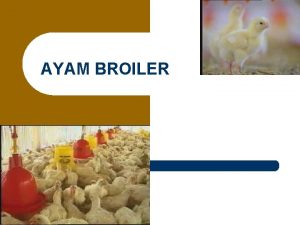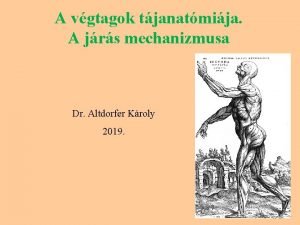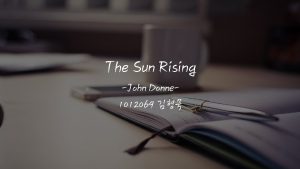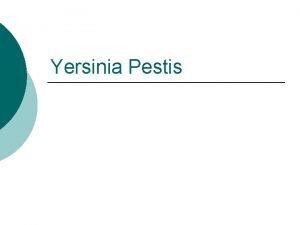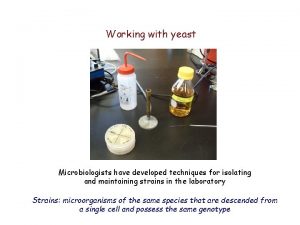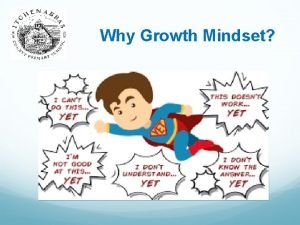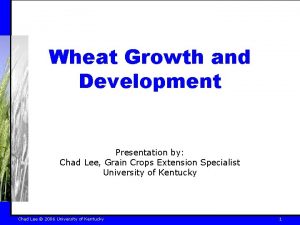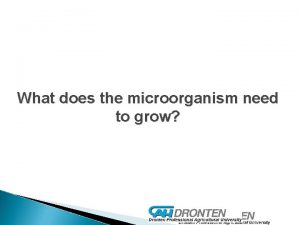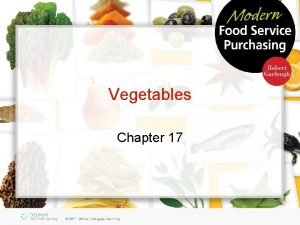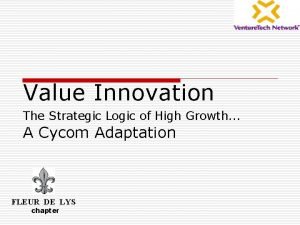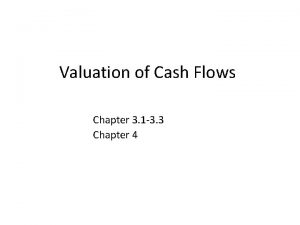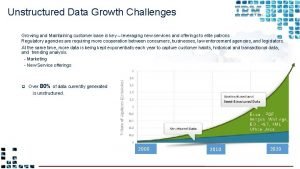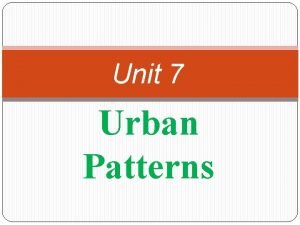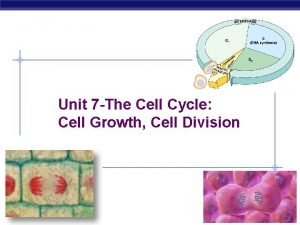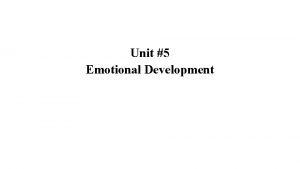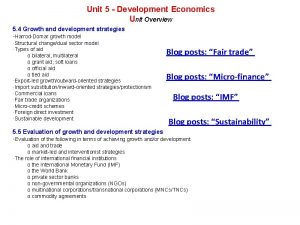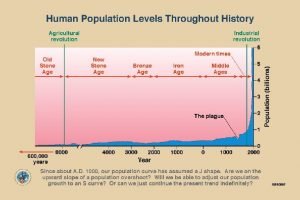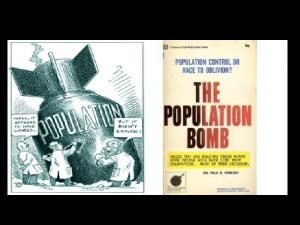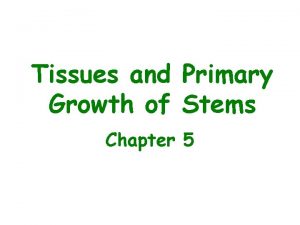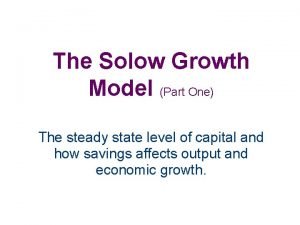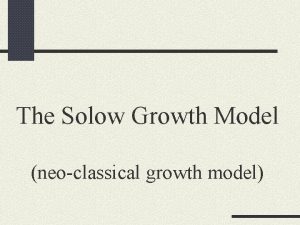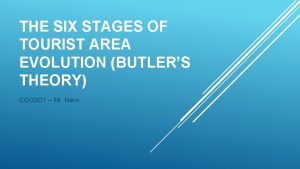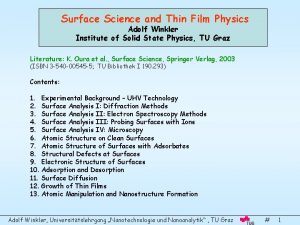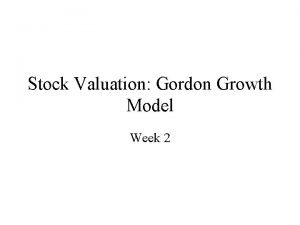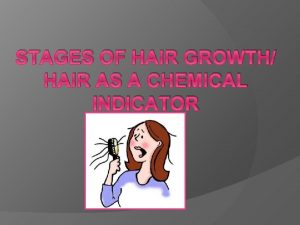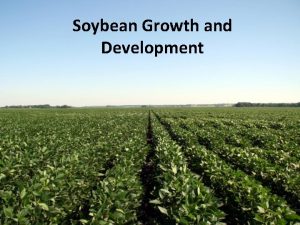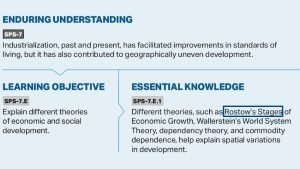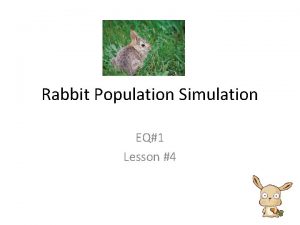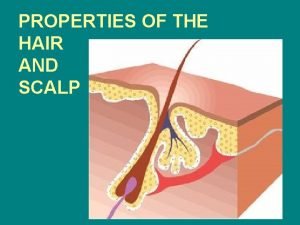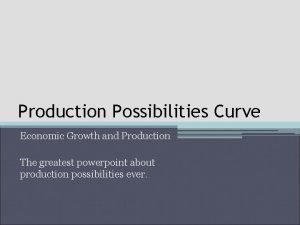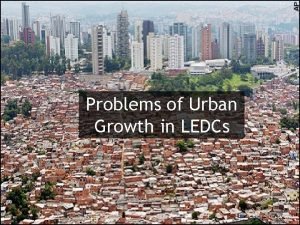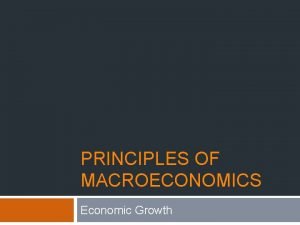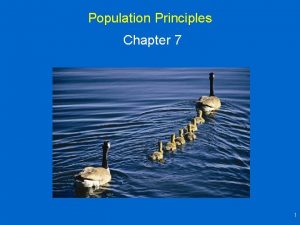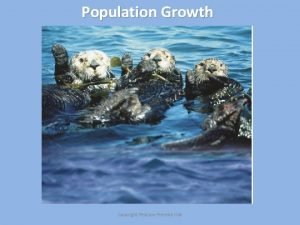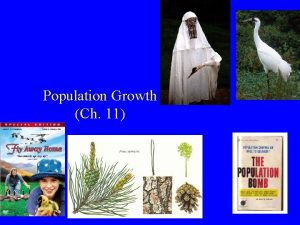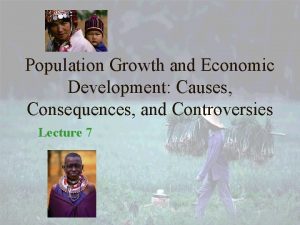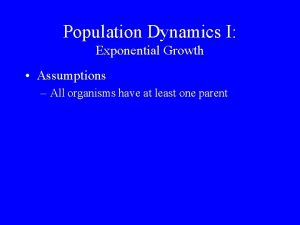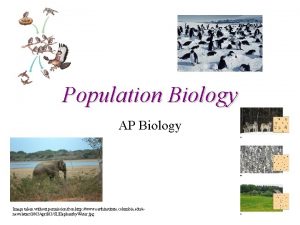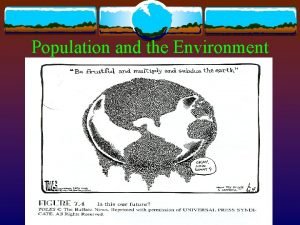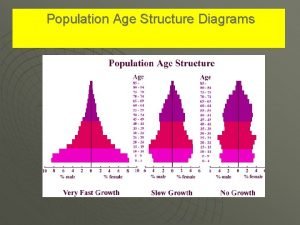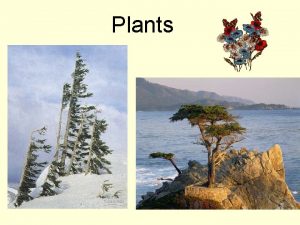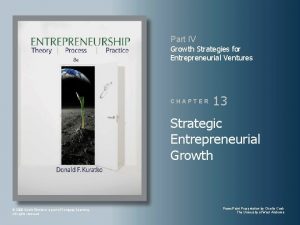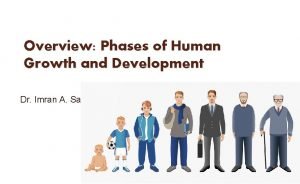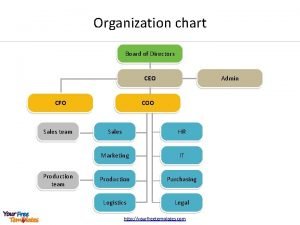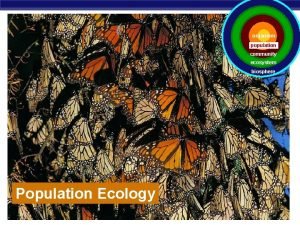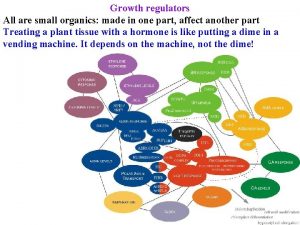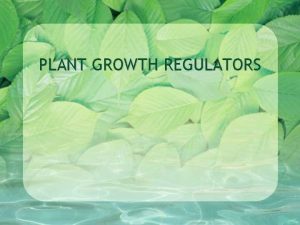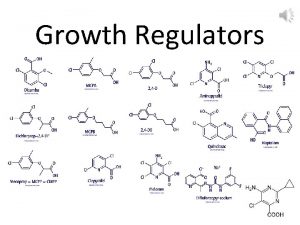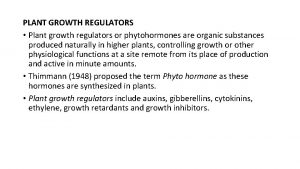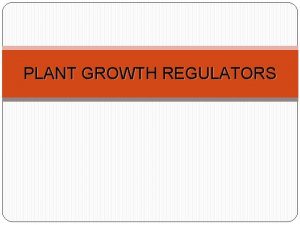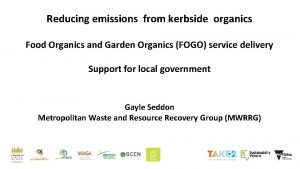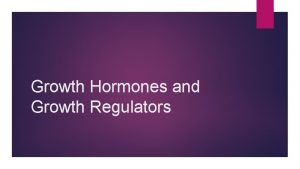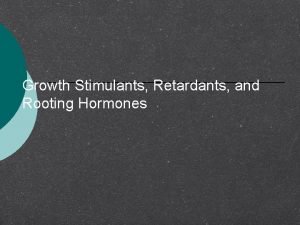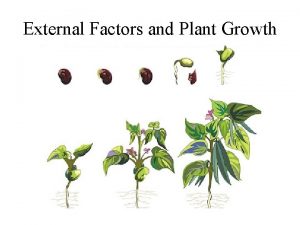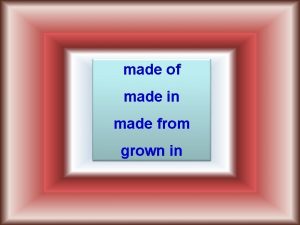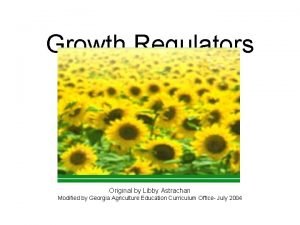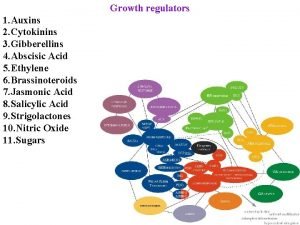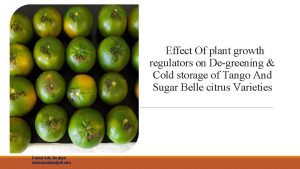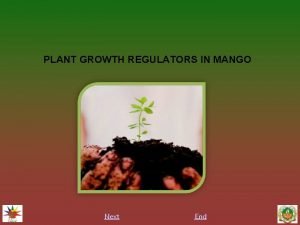Growth regulators All are small organics made in












![Auxin Synthesis Made in leaves & transported to roots so [IAA] decreases going down Auxin Synthesis Made in leaves & transported to roots so [IAA] decreases going down](https://slidetodoc.com/presentation_image_h/93b921194255e6424a05294719527f46/image-13.jpg)



![Auxin Levels No way to run out of IAA! [IAA] depends on metabolism Auxin Levels No way to run out of IAA! [IAA] depends on metabolism](https://slidetodoc.com/presentation_image_h/93b921194255e6424a05294719527f46/image-17.jpg)
![Auxin Levels No way to run out of IAA! [IAA] depends on metabolism Most Auxin Levels No way to run out of IAA! [IAA] depends on metabolism Most](https://slidetodoc.com/presentation_image_h/93b921194255e6424a05294719527f46/image-18.jpg)
![Auxin Levels No way to run out of IAA! [IAA] depends on metabolism Most Auxin Levels No way to run out of IAA! [IAA] depends on metabolism Most](https://slidetodoc.com/presentation_image_h/93b921194255e6424a05294719527f46/image-19.jpg)
![Auxin Levels No way to run out of IAA! [IAA] depends on metabolism Most Auxin Levels No way to run out of IAA! [IAA] depends on metabolism Most](https://slidetodoc.com/presentation_image_h/93b921194255e6424a05294719527f46/image-20.jpg)









































































![• • Cytokinin Effects SAM & plants are smaller when [CK] Roots are • • Cytokinin Effects SAM & plants are smaller when [CK] Roots are](https://slidetodoc.com/presentation_image_h/93b921194255e6424a05294719527f46/image-94.jpg)

- Slides: 95

Growth regulators All are small organics: made in one part, affect another part Treating a plant tissue with a hormone is like putting a dime in a vending machine. It depends on the machine, not the dime!

Auxin First studied by Darwins! Showed that a "transmissible influence" made at tips caused bending lower down No tip, no curve!

Auxin 1919: Paal showed that if tip was replaced asymmetrically, plant grew asymmetrically even in dark Uneven amounts of "transmissible influence" makes bend 1926: Went showed that a chemical that diffused from tips into blocks caused growth If placed asymmetrically get bending due to asymmetrical growth Amount of bending depends on [auxin] 1934: Indole-3 -Acetic acid (IAA) from the urine of pregnant women was shown to cause bending

Auxin IAA is the main auxin in vivo. Many synthetic auxins have been identified No obvious structural similarity, yet all work!

Auxin IAA is the main auxin in vivo. Many synthetic auxins have been identified No obvious structural similarity, yet all work! Widely used in agriculture • to promote growth (flowering, cuttings) IAA

Auxin IAA weed killers! Agent orange was 1: 1 2, 4 -D and 2, 4, 5 -T was contaminated with dioxin 2, 4 -D is still widely used: selectively kills dicots Controls weeds in monocot crops (corn, rice, wheat) Mech unclear: may cause excess ethylene or ABA production.

Auxin >90%of IAA is conjugated to sugars in vivo!

Auxin >90%of IAA is conjugated to sugars in vivo! Inactive, but readily activated!

Auxin >90%of IAA is conjugated to sugars in vivo! Inactive, but readily activated! Best way to measure [auxin] is bioassay!

Auxin >90%of IAA is conjugated to sugars in vivo! Inactive, but readily activated! Best way to measure [auxin] is bioassay! Critical concentration varies between tissues

Auxin >90%of IAA is conjugated to sugars in vivo! Inactive, but readily activated! Best way to measure [auxin] is bioassay! Critical concentration varies between tissues Roots are much more sensitive than leaves!

Auxin Critical concentration varies between tissues Roots are much more sensitive than leaves! Made in leaves & transported to roots so [IAA] decreases going down the plant Most cells are IAA sinks!
![Auxin Synthesis Made in leaves transported to roots so IAA decreases going down Auxin Synthesis Made in leaves & transported to roots so [IAA] decreases going down](https://slidetodoc.com/presentation_image_h/93b921194255e6424a05294719527f46/image-13.jpg)
Auxin Synthesis Made in leaves & transported to roots so [IAA] decreases going down the plant Most is made from trp

Auxin Synthesis Most is made from trp Also made by trp-independent pathway: exits before trp

Auxin Synthesis Most is made from trp Also made by trp-independent pathway: exits before trp Path used varies between tissues

Auxin Synthesis Most is made from trp Also made by trp-independent pathway: exits before trp Path used varies between tissues No way to run out of IAA
![Auxin Levels No way to run out of IAA IAA depends on metabolism Auxin Levels No way to run out of IAA! [IAA] depends on metabolism](https://slidetodoc.com/presentation_image_h/93b921194255e6424a05294719527f46/image-17.jpg)
Auxin Levels No way to run out of IAA! [IAA] depends on metabolism
![Auxin Levels No way to run out of IAA IAA depends on metabolism Most Auxin Levels No way to run out of IAA! [IAA] depends on metabolism Most](https://slidetodoc.com/presentation_image_h/93b921194255e6424a05294719527f46/image-18.jpg)
Auxin Levels No way to run out of IAA! [IAA] depends on metabolism Most cells are IAA sinks!
![Auxin Levels No way to run out of IAA IAA depends on metabolism Most Auxin Levels No way to run out of IAA! [IAA] depends on metabolism Most](https://slidetodoc.com/presentation_image_h/93b921194255e6424a05294719527f46/image-19.jpg)
Auxin Levels No way to run out of IAA! [IAA] depends on metabolism Most cells are IAA sinks! IAA is made at shoot apex & transported down: basipetal
![Auxin Levels No way to run out of IAA IAA depends on metabolism Most Auxin Levels No way to run out of IAA! [IAA] depends on metabolism Most](https://slidetodoc.com/presentation_image_h/93b921194255e6424a05294719527f46/image-20.jpg)
Auxin Levels No way to run out of IAA! [IAA] depends on metabolism Most cells are IAA sinks! IAA is made at shoot apex & transported down: basipetal IAA transport therefore affects growth & development

Auxin Transport IAA transport therefore affects growth & development is polar and basipetal: New roots form at base of stem even if stored upside-down

Auxin Transport IAA transport therefore affects development: is polar and basipetal. New roots form at base of stem even if stored upside-down. Stem sections only move IAA basipetally

Chemiosmotic Auxin Transport 1. Apoplastic IAAH diffuses into cell • IAAH due to low p. H

Chemiosmotic Auxin Transport 1. Apoplastic IAAH diffuses into cell • IAAH due to low p. H • AUX 1 pumps in IAA- -

Chemiosmotic Auxin Transport 1. Apoplastic IAAH diffuses into cell • IAAH due to low p. H • AUX 1 pumps in IAA 2. In cell IAAH-> IAA- due to p. H 7. 2 -

Chemiosmotic Auxin Transport 1. Apoplastic IAAH diffuses into cell • IAAH due to low p. H • AUX 1 pumps in IAA 2. In cell IAAH-> IAA- due to p. H 7. 2, , draws more IAAH -

Chemiosmotic Auxin Transport 1. Apoplastic IAAH diffuses into cell • IAAH due to low p. H • AUX 1 pumps in IAA 2. In cell IAAH-> IAA- due to p. H 7. 2, draws more IAAH 3. IAA- is pumped out by PIN proteins in basal part of cell -

Chemiosmotic Auxin Transport 1. Apoplastic IAAH diffuses into cell • IAAH due to low p. H • AUX 1 pumps in IAA 2. In cell IAAH-> IAA- due to p. H 7. 2, draws more IAAH 3. IAA- is pumped out by PIN proteins in basal part of cell 4. In apoplast IAA- -> IAAH due to low p. H Cycle repeats

Chemiosmotic Auxin Transport Supporting evidence 1. Some chemicals specifically block import or export

Chemiosmotic Auxin Transport Supporting evidence 1. Some chemicals specifically block import or export • Export blockers stop efflux into block, no effect on uptake

Chemiosmotic Auxin Transport Supporting evidence 1. Some chemicals specifically block import or export • Export blockers stop efflux into block, no effect on uptake • Import blockers stop uptake

Chemiosmotic Auxin Transport Supporting evidence 1. Some chemicals specifically block import or export • Export blockers stop efflux , no effect on uptake • Import blockers stop uptake • Both mess up development!

Chemiosmotic Auxin Transport Supporting evidence 1. Some chemicals specifically block import or export • Export blockers stop efflux , no effect on uptake • Import blockers stop uptake • Both mess up development! • Natural transport inhibitors have anti-cancer activity!

Chemiosmotic Auxin Transport Supporting evidence 1. Some chemicals specifically block import or export • Export blockers stop efflux , no effect on uptake • Import blockers stop uptake • Both mess up development! • Natural transport inhibitors have anti-cancer activity! • Genistein binds estrogen receptors

Chemiosmotic Auxin Transport Supporting evidence 1. Some chemicals specifically block import or export • Both mess up development! 2. AUX 1 encodes an IAA-H+ symporter found at top of cell

Chemiosmotic Auxin Transport Supporting evidence 1. Some chemicals specifically block import or export • Both mess up development! 2. AUX 1 encodes an IAA-H+ symporter found at top of cell aux 1 resemble plants treated with import blockers

Chemiosmotic Auxin Transport Supporting evidence 1. Some chemicals specifically block import or export 2. AUX 1 encodes an IAA-H+ symporter found at top of cell • aux 1 resemble plants treated with import blockers 3. PINs encode IAA exporters found at cell base

Chemiosmotic Auxin Transport Supporting evidence 1. Some chemicals specifically block import or export 2. AUX 1 encodes an IAA-H+ symporter found at top of cell • aux 1 resemble plants treated with import blockers 3. PINs encode IAA exporters found at cell base • pin 1 resemble plants treated with export blockers

Auxin Action Two models: 1. Acid growth: IAA starts H+ pumping that loosens cell wall

Auxin Action Two models: 1. Acid growth: IAA starts H+ pumping that loosens cell wall • Low p. H is sufficient to cause elongation

Auxin Action Two models: 1. Acid growth: IAA starts H+ pumping that loosens cell wall • Low p. H is sufficient to cause elongation • H+ pump activators cause elongation

Auxin Action Two models: 1. Acid growth: IAA starts H+ pumping that loosens cell wall 2. Gene activation

Auxin Action IAA activates cell elongation & transcription in targets

Auxin Action IAA activates cell elongation & transcription in targets Elongation has lag of 10'

Auxin Action IAA activates cell elongation & transcription in targets Elongation has lag of 10' IAA induces PM H+ pump with 10' lag

Auxin Action IAA induces PM H+ pump with 10' lag • Acid- growth: IAA-induced p. H drop activates expansins & glucanases

Auxin Action IAA induces PM H+ pump with 10' lag • Acid- growth: IAA-induced p. H drop activates expansins & glucanases • Lag may represent time needed to move H+ pump to PM

Active transport H+ pumps lower p. H in lysosomes, stomach

Auxin Action IAA induces PM H+ pump with 10' lag • Acid- growth: IAA-induced p. H drop activates expansins & glucanases • Lag may represent time needed to move H+ pump to PM • Gnom mutants stop transport of PIN 1 to PM = links GTP exchange factor & development

Auxin Action IAA induces PM H+ pump with 10' lag • Acid- growth: IAA-induced p. H drop activates expansins & glucanases • Lag may represent time needed to move H+ pump to PM • Also have SAUR genes expressed w/in 10'!

Auxin Action Acid- growth: IAA-induced p. H drop activates expansins & glucanases Phototropism is due to more elongation on shaded side

Auxin Action Acid- growth: IAA-induced p. H drop activates extensins & glucanases Phototropism is due to more elongation on shaded side due to lateral IAA redistribution

Auxin Action Acid- growth: IAA-induced p. H drop activates extensins & glucanases Phototropism is due to more elongation on shaded side due to lateral IAA redistribution IAA export blockers stop phototropism

Auxin Action Phototropism is due to more elongation on shaded side due to lateral IAA redistribution IAA export blockers stop phototropism PIN 1 goes away in cells on light side & PIN 3 on cell sides takes over

Auxin Action Phototropism is due to more elongation on shaded side due to lateral IAA redistribution IAA export blockers stop phototropism PIN 1 goes away in cells on light side & PIN 3 on cell sides takes over IAA moves sideways

Auxin Action Phototropism is due to more elongation on shaded side due to lateral IAA redistribution IAA export blockers stop phototropism PIN 1 goes away in cells on light side & PIN 3 on cell sides takes over IAA moves sideways Lower p. H on shaded side enhances IAA uptake

Auxin Action Gravitropism Shoots bend up!

Auxin Action Gravitropism • Shoots bend up! • Roots bend down!

Auxin Action Gravitropism • Shoots bend up! • Roots bend down! Both effects are due to IAA redistribution to lower side!

Auxin Action Gravitropism • Shoots bend up, Roots bend down Both effects are due to IAA redistribution to lower side! [IAA] stimulates shoots & inhibits roots!

Apical dominance Auxin inhibits lateral bud formation • decapitate plant and lateral buds develop

Apical dominance Auxin inhibits lateral bud formation • decapitate plant and lateral buds develop • apply IAA to cut tip & lateral buds do not develop

Apical dominance Auxin induces lateral & adventitious roots

Apical dominance Auxin induces lateral & adventitious roots • Promotes cell division at initiation site

Apical dominance Auxin induces lateral & adventitious roots • Promotes cell division at initiation site • Promotes cell elongation & viability as root grows

Auxin signaling Used "auxin-resistant" mutants to find genes involved in auxin signaling

Auxin signaling Used "auxin-resistant" mutants to find genes involved in auxin signaling Many are involved in selective protein degradation!

Auxin signaling Used "auxin-resistant" mutants to find genes involved in auxin signaling Many are involved in selective protein degradation! Some auxin receptors, eg TIR 1 are E 3 ubiquitin ligases!

Auxin signaling Auxin receptors eg TIR 1 are E 3 ubiquitin ligases! Upon binding auxin they activate complexes targeting AUX/IAA proteins for degradation!

Auxin signaling Auxin receptors eg TIR 1 are E 3 ubiquitin ligases! Upon binding auxin they activate complexes targeting AUX/IAA proteins for degradation! AUX/IAA inhibit ARF transcription factors, so this turns on "early genes"

Auxin signaling Auxin receptors eg TIR 1 are E 3 ubiquitin ligases! Upon binding auxin they activate complexes targeting AUX/IAA proteins for degradation! AUX/IAA inhibit ARF transcription factors, so this turns on "early genes" Some early genes turn on 'late genes" needed for development

Auxin signaling ABP 1 is a different IAA receptor localized in ER • Activates PM H+ pump by sending it to PM & keeping it there

Auxin signaling ABP 1 is a different IAA receptor localized in ER • Activates PM H+ pump by sending it to PM & keeping it there • Does not affect gene expression!

Auxin & other growth regulators ABP 1 is a different IAA receptor localized in ER • Stimulates PM H+ pump by sending it to PM & keeping it there. • Does not affect gene expression! • Some "late genes" synthesize ethylene (normally a wounding response): how 2, 4 -D kills?

Auxin & other growth regulators • Some "late genes" synthesize ethylene (normally a wounding response): how 2, 4 -D kills? • Auxin/cytokinin determines whether callus forms roots or shoots

Cytokinins Discovered as factors which induce cultured cells to divide Haberlandt (1913): phloem chemical stimulates division

Cytokinins Discovered as factors which induce cultured cells to divide Haberlandt (1913): phloem chemical stimulates division van Overbeek (1941): coconut milk stimulates division

Cytokinins Discovered as factors which induce cultured cells to divide Haberlandt (1913): phloem chemical stimulates division van Overbeek (1941): coconut milk stimulates division Miller… Skoog (1955): degraded DNA stimulates division!

Cytokinins Discovered as factors which induce cultured cells to divide Haberlandt (1913): phloem chemical stimulates division van Overbeek (1941): coconut milk stimulates division Miller… Skoog (1955): degraded DNA stimulates division! Kinetin was the breakdown product

Cytokinins Discovered as factors which induce cultured cells to divide Haberlandt (1913): phloem chemical stimulates division van Overbeek (1941): coconut milk stimulates division Miller… Skoog (1955): degraded DNA stimulates division! Kinetin was the breakdown product Derived from adenine

Cytokinins Discovered as factors which induce cultured cells to divide Haberlandt (1913): phloem chemical stimulates division van Overbeek (1941): coconut milk stimulates division Miller… Skoog (1955): degraded DNA stimulates division! Kinetin was the breakdown product Derived from adenine Requires auxin to stimulate division

Cytokinins Requires auxin to stimulate division Kinetin/auxin determines tissue formed (original fig)

Cytokinins Requires auxin to stimulate division Kinetin/auxin determines tissue formed Inspired search for natural cytokinins Miller& Letham (1961) ± simultaneously found zeatin in corn Kinetin trans- Zeatin

Cytokinins Miller& Letham (1961) ± simultaneously found zeatin Later found in many spp including coconut milk Kinetin trans-Zeatin

Cytokinins Miller& Letham (1961) ± simultaneously found zeatin Later found in many spp including coconut milk Trans form is more active, but both exist (& work) Many other natural & synthetics have been identified

Cytokinins Many other natural & synthetics have been identified Like auxins, many are bound to sugars or nucleotides

Cytokinins Many other natural & synthetics have been identified Like auxins, many are bound to sugars or nucleotides Inactive, but easily converted

Cytokinin Synthesis Most cytokinins are made at root apical meristem & transported to sinks in xylem

Cytokinin Synthesis Most cytokinins are made at root apical meristem & transported to sinks in xylem Therefore have inverse gradient with IAA

Cytokinin Synthesis Most cytokinins are made at root apical meristem & transported to sinks in xylem Therefore have inverse gradient with IAA Why IAA/CK affects development

Cytokinin Synthesis Most cytokinins are made at root apical meristem & transported to sinks in xylem Therefore have inverse gradient with IAA Why IAA/CK affects development Rapidly metabolized by sink

Cytokinin Effects Regulate cell division • Need mutants defective in CK metabolism or signaling to detect this in vivo

Cytokinin Effects Regulate cell division • Need mutants defective in CK metabolism or signaling to detect this in vivo • SAM & plants are smaller when [CK]
![Cytokinin Effects SAM plants are smaller when CK Roots are • • Cytokinin Effects SAM & plants are smaller when [CK] Roots are](https://slidetodoc.com/presentation_image_h/93b921194255e6424a05294719527f46/image-94.jpg)
• • Cytokinin Effects SAM & plants are smaller when [CK] Roots are longer!

• • Cytokinin Effects Usually roots have too much CK: inhibits division! Cytokinins mainly act @ root & shoot meristems
 Insidan region jh
Insidan region jh Midwest organics recycling
Midwest organics recycling Gmail
Gmail Doc scurlock
Doc scurlock North american gaming regulators association
North american gaming regulators association Ac voltage controller and cycloconverter
Ac voltage controller and cycloconverter Occulistics
Occulistics Emitter follower voltage regulator
Emitter follower voltage regulator Insulin
Insulin Name three line segments
Name three line segments What is plant growth analysis
What is plant growth analysis Pith
Pith Growthchain
Growthchain Primary growth and secondary growth in plants
Primary growth and secondary growth in plants Chapter 35 plant structure growth and development
Chapter 35 plant structure growth and development Geometric growth population
Geometric growth population Neoclassical growth theory vs. endogenous growth theory
Neoclassical growth theory vs. endogenous growth theory Organic vs inorganic growth
Organic vs inorganic growth Managing growth in small business
Managing growth in small business Pythagoras 6 8 10
Pythagoras 6 8 10 Seth made a small rectangular table
Seth made a small rectangular table Small grain like body made primarily of rna
Small grain like body made primarily of rna All matter is made up of
All matter is made up of Element mixture and compound diagram
Element mixture and compound diagram I have made myself a slave to all
I have made myself a slave to all Gênesis 41 52
Gênesis 41 52 All matter is made up of
All matter is made up of Are all things made of atoms
Are all things made of atoms Love all serve all
Love all serve all Interventi sociali rivolti alla persona
Interventi sociali rivolti alla persona Above all powers above all kings
Above all powers above all kings I work all night
I work all night All to one reduction
All to one reduction Sistem all in all out
Sistem all in all out Spf -all vs ~all
Spf -all vs ~all Silent night holy night all is calm all is bright
Silent night holy night all is calm all is bright Jesus lamb of god worthy is your name
Jesus lamb of god worthy is your name All of you is more than enough for all of me
All of you is more than enough for all of me She's all states and all princes i nothing else is
She's all states and all princes i nothing else is What height of love what depth of peace
What height of love what depth of peace Above all powers above all kings
Above all powers above all kings Stalactite growth yersinia
Stalactite growth yersinia Yeast growth curve
Yeast growth curve Matthew syed growth mindset
Matthew syed growth mindset Fundraising growth platform
Fundraising growth platform Feekes growth stages
Feekes growth stages Factors affecting microbial growth in food
Factors affecting microbial growth in food Edible stems pictures with names
Edible stems pictures with names Value innovation the strategic logic of high growth
Value innovation the strategic logic of high growth Perpetuity growth formula
Perpetuity growth formula Unstructured data growth
Unstructured data growth Borchert's model of urban growth
Borchert's model of urban growth Onion root tip mitosis stages
Onion root tip mitosis stages Emotional growth definition
Emotional growth definition Harrod-domar model
Harrod-domar model Rule of 70 in population growth
Rule of 70 in population growth Social changes in adulthood
Social changes in adulthood Slow growth age structure diagram
Slow growth age structure diagram What are the two types of population growth
What are the two types of population growth Vascular cambium
Vascular cambium Solow growth model
Solow growth model Solow's model of economic growth
Solow's model of economic growth Tourist stage
Tourist stage Unstructured data growth
Unstructured data growth Step flow growth
Step flow growth Sol score range
Sol score range Gordon growth model
Gordon growth model Different hair roots
Different hair roots St mary's county land use and growth management
St mary's county land use and growth management Interest rates and economic growth
Interest rates and economic growth Soybean growth stages
Soybean growth stages Rostows stages of development
Rostows stages of development Modeling population growth rabbits answer key
Modeling population growth rabbits answer key Hair stream growth pattern
Hair stream growth pattern Ppc curve economic growth
Ppc curve economic growth Urbanisation in ledcs
Urbanisation in ledcs Long run economic growth
Long run economic growth Different theories of growth and development
Different theories of growth and development Population growth curve
Population growth curve Copyright
Copyright Geometric growth example
Geometric growth example Why population growth is good
Why population growth is good What is population ecology
What is population ecology Clumped dispersion
Clumped dispersion Exponential growth formula ecology
Exponential growth formula ecology Age structure diagram slow growth
Age structure diagram slow growth Nt=n0ert calculator
Nt=n0ert calculator Logistic growth ap bio
Logistic growth ap bio Arithmetically vs geometrically growth
Arithmetically vs geometrically growth Age-structure diagrams
Age-structure diagrams Tracheids
Tracheids Plant biology ppt
Plant biology ppt Entrepreneurial mindset
Entrepreneurial mindset Stages of human growth and development pictures
Stages of human growth and development pictures Cfo org chart
Cfo org chart Population community ecosystem
Population community ecosystem

